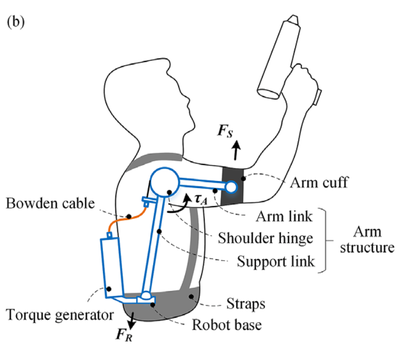Actuation

(a) The structure of the spring-cam mechanism. (b) When the arm is raised up ( is close to 180 ), the spring is not compressed ( is zero) and the force of cable B ( 𝐹2 ) is zero. (c) If 𝛼 is around 90∘ , the spring is compressed ( is large), since the force arms ( and ) are almost equal, is also large. (d) When the user puts down the arm ( is around zero), the spring is fully compressed ( reaches the maximum value), however since is much smaller than , can be small. (e) Test bench to validate the assistive torque output. (f) Assistive torque of the torque generator (and the load torque on shoulder) as a function of the shoulder flexion angle. The load torque is estimated by Van Engelhoven et al. for 95% males (arm mass 6.2 kg) holding a tool of 2.25 kg (close to the tool weight in our experiments).
The passive version of our device includes an embedded real-time controller that coommands the torque of a brushless electric motor through a Series Elastic Actuator (SEA) to achieve an inherently compliant mechanism and force control. The active device also includes on-board motion sensors that let the controller intelligently determine the assistive torque needed based on the pose and motion of the joint and adjust the assistance in real-time. The active device weights around 3.5kg is capable of delivering up to 30 Nm of assistive torque to the shoulder joint. The use of a real-time controller also allows us to implement a variety of control strategies to improve the performance of the device in different working conditions.
Van Engelhoven, Logan, et al. "Experimental evaluation of a shoulder-support exoskeleton for overhead work: Influences of peak torque amplitude, task, and tool mass." IISE Transactions on Occupational Ergonomics and Human Factors 7.3-4 (2019): 250-263.


